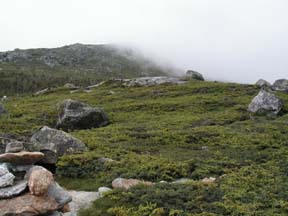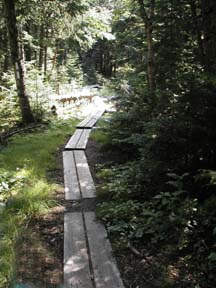|
|
Mount St. HelensAugust 27 - 29, 2001 What can I say to describe Mount St. Helens? I'll just start with "WOW". This place is incredible. It is hard to believe it was only 21 years ago that this mountain erupted and is still an active volcano. I remember the news stories at the time and how incredible this seemed. Well, you come out here now and take a look at this and the devastation that is still clearly visible blows the mind. Stayed overnight here on Silver Lake (near Castle Rock) on the visitor center side of the mountain. Went up to Sediment Dam the first night. Basically ran down the trail to the dam as it was in the evening and we ran back on the trail trying to beat the sunset by getting back to the car just before it got really dark out. This dam is really cool. Basically, it was built to clean the Toutle River of the sediment from the volcano. In all, they believe it will take about 50 years from the eruption to clean the river. The Silver Lake Motel may not have the best mattresses, but the lake and the view of the mountain make it well worth staying here. Silver Lake with Mt St Helens in the background and a Heron in the lake
Sediment Dam
The next day, we hiked the mountain. One of the most incredible things I have ever done! We went to Jack's Restaurant and Store where you pick up your permit (only 100 climbers allowed per day in the spring - fall) $15.00/person and sign in and out from your hike. From there we drove to Climbers Bivouac. Saw a baby deer and mom on the side of the road. This road is very curvy and allows for some really gorgeous vistas. Parked at Climbers Bivouac about 3700 ft in elevation and started the 5.5 mile (one way - 11 miles roundtrip) hike to the summit.
Why permits? The climbing permit system has been in effect since 1987 when Mount St. Helens was reopened for climbing. The system protects the volcano's physical and biological features and processes, reduces crowding, provides climbers with information on current climbing conditions, low impact use, and safety. This was definitely the MOST incredible hike I have ever done. The first 2 miles are below the tree line and the trail is relatively easy going. Little elevation and cool in the shade. Then you come out to the 4800 foot elevation mark and the beginning of the area where you must have a climbing permit. This looks surreal with volcanic rock and sand and a very steep and rugged climb ahead for the next 3.5 miles. You see ice sheets (glaciers I would call them, but the Gifford Pinchot National Forest information states: "There are no active glaciers on Mount St. Helens. There are however, large permanent snow fields which may be very icy and may have large glide cracks or bergschrunds."), which look so out of place in this area of incredible desolation. And no shade for the next several hours. In all, the climb up took us about 5 hours and 15 minutes. The trip down, about 3 hours. The route to the crater rim is on the Monitor Ridge route from Climbers Bivouac. The elevation gain is about 4,500 feet to the crater rim, which is at 8,365 feet in elevation. The route begins on the Ptarmigan Trail #216-A which climbs 1,100 feet in 2 1/4 miles to timberline at the 4,800 foot level. Toilets are located at Climbers Bivouac and near timberline. Above timberline, the route generally follows Monitor Ridge, climbing steeply through blocky lava flows and loose pumice and ash. From timberline the route is marked with large wooden posts to about 7,000 feet elevation. The upper 1,300 feet of the route is unmarked and covered with loose, pumice and ash. The rim is precipitous with drops of nearly 2,000 feet to the crater floor. A snow cornice develops in winter and often lasts into summer. The hike begins...
Above Tree Line (the trail gets really tough)
See the paths within all the volcanic rock and ash/sand? That really is the trail...
You can see the volcano from two other sides of the mountain. Most notably those of the visitor centers. However, you will never come close to truly seeing and understanding what happened here unless you climb it. Believe me, this was amazing and brutal. Climbing the volcano is not a trail hike, it is a rugged, off-trail scramble and is not for everyone. I had trouble walking for a couple of days after climbing this, but it was well worth it.
Mts Hood, Adams and Ranier from Mt St Helens crater rim
Fog kept blowing in and out of the crater. It was amazing.
The caldera and crater dome. The dome is about 70 stories high and the drop into the crater about 2000 feet from the rim. You can see the beginnings of glacier growth around the dome and crevasses (see right side of dome) where steam often comes out of the volcano.
Left and right rims of the crater that are not shown on the above panorama
|
|
|



















 Lunch
Lunch







